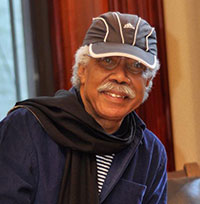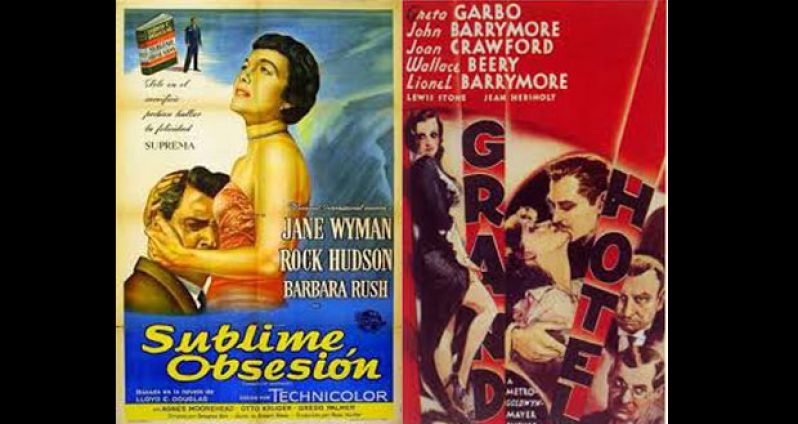by Terence Roberts
Because the importance of movies to Guyanese society does not depend only on movies created at present anywhere but rather on the specific content of movies going back in time, the society is intellectually and morally compelled to consume movies which are relevant to the social betterment of itself.

Two basic obstacles stand in the way of achieving this today: (1) The privatization of duplicated films for buyers and borrowers free to choose whatever they wish to see and (2) The end of cinemas with professional staff members knowledgeable about past and present films, and who chose them for the public based on sound knowledge.
So permanently important is this second function that even in all the metropolitan cities where all the latest movies are seen in Cineplex box cinemas, there are Film Centers with large auditoriums (the Lincoln Film Center, and MOMA Film Program in New York, the TIFF Center in Toronto, the BFI Center in London, etc), which show every day mostly films from the 1930s to the 1980s, for the simple reason that a large percentage of citizens ( including students of film and hardcore film fans) know that the social concerns, creative freedom and conscientious commitment of film producers, directors, actors and actresses, are far less, or even sought after now, since films have largely become technical or scientific projects and sensational audio-visual entertainment.
However, the films of the past 20th century still exist, are carefully preserved, and maintain their overall superior social value when compared to present day films, give and take about 10% of new exceptions. On TV, the TCM channel offers 24 hours of the best vintage films, an interest which Neflix does not share. Yet it is said that 60% of TCM devotees are between the ages of 25 and 54, and they include leading filmmakers of today, like Scorcese, Spielberg, and Sidney Lumet, among others. Soon TCM will include films from the international Criterion Collection, the best films on DVD, period.
Such a comparison reveals that most of today’s metropolitan films are inevitably concerned with their own present day hi-tech urban environments, and endless forms of crime and violence within it, or threatening it; or with futuristic and fantastic scenarios which act as audio-visual consumer play things.
For the metropolitan viewer, such films and TV programs are primarily entertaining past times which exaggerate or distract from their mundane day-to-day real problems. This new production style of countless metropolitan films today differs drastically from the content of films made between the 30s and 80s, at least.
For Guyanese citizens in all their diversity, a myriad of social problems rooted in the individual character of citizens, and debated, discussed, bemoaned today, can only be ignored by a popular consumer medium like movies to the detriment and bewildering decay of their social fabric; despite an increase in salaries, new governments, new electronic gadgets, new industries, jobs, religious and charitable organizations, international foundations, schools, universities, etc. In fact, these social problems can even be activated or increased by various adopted aspirations transmitted subliminally to gullible minds of a current Guyanese generation by current metropolitan films devoid of any relevance to the everyday human lives within their nation or society.
Looking at those decades between the 1930s and 70s in Guyana (excluding the political riots, vandalism, and ethnic violence between 1962 and 64), an undisputed far lower occurrence of robberies, homicides, public corruption, public garbage dumping, uneducated opinions, speech and behavior, existed in that far less prosperous era when most white-collar workers rode bicycles to work, when a refrigerator at home, much less a car, was a privilege; when gunshots in neighborhoods, even by the police, were unheard of, when downtown Georgetown was alive with cinema programmes, plays, restaurants and late night window shopping, and local yards with lawns, white fences and flower gardens looked like those in 1950s Hollywood color films.
All this cannot be attributed to some sort of strict dictatorial pre or post-colonial State control, or only to the effect of school teachers, priests and religious doctrines, but rather to the daily availability and popular consumption and attention paid to about 150 American and European films seen weekly in nine Georgetown cinemas, supported by informed weekly reviews of new releases. If anyone thinks those films were mostly action-packed, shoot-em-up Westerns, and violent crime dramas, they should think again, and perhaps put aside their prejudices and see countless precious films which set a high social standard while guiding the personal character, behavior, even appearance of all races and classes locally.
The fact that cinema-goers had no choice but to accept what films were chosen by intelligent cinema staff (unlike viewing personal DVDs subject to distractions at home), and after paying would have to walk out if one disliked the film, meant that the most ordinary people sitting in the stalls ended up seeing for 15 cents some of the best films ever made. They quickly became hooked on the cinematic art-form.
What they saw was hardly forgotten after they exited; it became a pleasant social method whereby they exercised reason, common sense, understanding, sympathetic and cautious behavior. This all depended on the type of films they were shown. In the 1930s such films would have been Grand Hotel, The Public Enemy, Ladies They Talk About, Red Dust, Honky Tonk, I Cover the Waterfront, Modern Times, ‘The Awful Truth, Stella Dallas, Love Before Breakfast, The Women, Lost Horizon, Boys Town, Scandal Sheet, Ann Vickers’ ‘Little Caesar, Golden Boy, ‘Mister Smith Goes To Washington, etc.
Such films may seem like nothing more than names on a page now, but to experience them in a crowded cinema with people of different race and class and character, circulated a conscientious feeling of self-awareness about one’s flaws, yet one’s potential for change.
By the 1940s, cinema attendance had become the most important collective Guyanese cultural activity, because of the broad range of social and personal issues it covered and criticized. Such a wide range of human issues Guyanese culture then or now could not equally produce in its own arts or mass media.
Critical issues of struggling poor families, colonial histories, artistic and social freedom, independent and educated women, non-white ethnic pleasures, kindness, racism, social work, alcoholism, socialism, shared living, criminality, etc., exist in outstanding 1940s films that were seen, such as How Green Was My Valley, The Letter, Mrs. Miniver, Woman Of the Year, In This Our Life, They Drive By Night, Stage Door Canteen, Cabin In the Sky, Stormy Weather, ‘The More the Merrier, Since You Went Away, The Palm Beach Story, ‘The Lost Weekend, ‘Mildred Pierce, ‘The Best Years Of Our Lives, ‘The Razor’s Edge, Monsieur Verdoux, Duel In the Sun, Body and Soul, Daisy Kenyon, Gentleman’s Agreement, ‘I remember Mama, ‘White Heat, Pinky, etc.
In the 1950s four colour films were made by Douglas Sirk, one of 1950s Hollywood best directors in style and content. Magnificent Obsession (1954); All That Heaven Allows (1956); Written on the Wind (1957); and Imitation of Life (1959).
They sum up the contrasting social and emotional values of hard work, the transformation of character, professional dedication, privilege, working class values, racism, art, bohemianism, age and youth, feminine and sexual freedom, jealousy, family prejudices, spoilt behaviour, shame, illness, tragedy, romantic affairs, individual reform, business ambition, tolerance.
Their diverse content ran like a conscientious fire creating tears in the eyes of local patrons in Georgetown neighbourhoods where the same issues in these films were familiar, and still is.
It was as if these films were locally made despite their cast and scenes in rustic North American states. The first three of these films starred Rock Hudson with serious actresses like Jane Wyman, Lauren Bacall, and Dorothy Malone.
When in the late 50s, a Rock Hudson flight was publicized to touch down at BGs airport, car loads of Guyanese women took off for the 25 miles to Atkinson Field, as the airport was then called, to be greeted by Rock who emerged at the top of the stairway to the plane and waved back while he grabbed some fresh air.
For those Guyanese men and women of yesterday, or today, it is not just the haunting indelible theme tunes from Magnificent Obsession and Written On the Wind which make them relevant and meaningful films, but the fact that the cars, the houses, the gloves the actresses wore, and the foreign settings of the films, had nothing whatsoever to do with their lasting value, only the human truth and acted social lessons of their stories.




.jpg)









